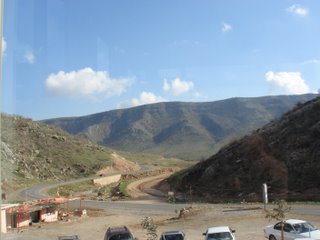 [Welcome to continuing coverage of my recent trip to Istanbul, southeastern Turkey and northern Iraq. Link below for previous posts.]
[Welcome to continuing coverage of my recent trip to Istanbul, southeastern Turkey and northern Iraq. Link below for previous posts.]
Kurdish nationalists refer to northern Iraq as South Kurdistan, merely one part of a country-in-waiting that overlaps present-day Turkey, Syria, Iran and Iraq. In a previous post I wrote that one could practically hit the Syrian border with a stone thrown from Cizre, in southern Turkey. To a Kurdish nationalist, you’d be throwing this stone from Kurdistan into Kurdistan. Most people we spoke to voiced support for full Kurdish independence, not just in northern Iraq but everywhere else.
Of the four sovereign countries that intersect Kurdistan, Turkey and Iraq have fought Kurdish nationalism with the most virulence. Turkey suppressed Kurdish culture for decades and has not spared civilians in its continuing fight against the unsavory PKK. Saddam Hussein committed genocide against Iraq’s Kurds in the infamous Anfal campaign of the late 1980s. If you’ve never read the extensive Human Rights Watch report on the Anfal campaign, it’s well worth the time. (“Iraqi troops tore through rural Kurdistan with the motion of a gigantic windshield wiper, sweeping first clockwise, then counterclockwise, through one after another of the ‘prohibited areas.’”)
At one point it struck me that I’ve never visited one of Europe’s Nazi death camps, but I’ve been to the former killing fields of Iraqi Kurdistan.
After conferring with our fixer, Yigal and I agreed that our home base for this trip should be Suleimaniya rather than Erbil. “Suli” was roughly six hours away. The roads were narrow and poorly maintained, so we weren’t keen on driving at night. But our fixer proved to be obsessively careful behind the wheel. We stopped for a late lunch in the hills just outside Dohuk (view from restaurant window above) and finally arrived in Suli at around 10 p.m.
—
I felt safe in Iraqi Kurdistan, and I had no real reason to doubt I’d remain safe. It was hard not to worry, however, especially when passing signs for Mosul or Kirkuk. But the peshmerga forces of the Kurdistan Democratic Party (KDP) and the Patriotic Union of Kurdistan (PUK) have a firm grip on the place. In fact, they have over 100,000 troops guarding their enclave—nearly as many troops as the U.S. sent to fight the entire Iraq war. As long as we saw the Kurdish flag—horizontal red, white and green with a yellow sun in the middle—we knew we were OK. On some government buildings the Iraqi flag also flew, but in its pre-1990 version, without “Allahu Akbar” in the middle.
There were frequent peshmerga checkpoints along every road, and even more near the cities. We were asked for our passports about half the time; otherwise, the word “American” from our fixer got us through with minimal fuss. The peshmerga were alert and imposing, stern yet approachable. The KDP troops wore sand-colored camouflage in the American style; the PUK wore green. Even harsh critics of the Kurdistan regional government readily agreed that the security record of the two parties is excellent. They have sealed off Kurdistan from the chaos that has engulfed the rest of Iraq. Once in a blue moon there will be an attack on a party headquarters or an official, but civilians seem largely free to go about their daily lives. (For more, see Michael Totten’s recent coverage of the area.)
The KDP and PUK stand together in Iraqi national elections but they continue to govern Iraqi Kurdistan separately. They even have separate cell phone networks, an absurd inefficiency. These are guerrilla armies that fought the Iraqi regime long before Saddam Hussein was a factor. Now they’re dealing with the awkward transition to governance, with mixed and controversial results (more about that later). Led first by Mulla Mustafa Barzani and now by his son Massoud, the KDP is the older of the two groups. The PUK, with firmly socialist roots, was formed in 1975. It is headed by Jalal Talabani, who now happens to be the president of Iraq. The KDP and PUK turned their guns on each other briefly in the mid-’90s, but now there is excited talk of them formally merging once and for all. (Some remain skeptical.)
The KDP holds sway in the north and west, including Erbil; the PUK controls the east, including Suleimaniya. During roughly the first half of the trip from Zakho to Suli, the checkpoints were KDP. Then they switched to PUK. Just after dark, our fixer slowed the car and turned on the overhead light, as per routine. “This is the last KDP checkpoint,” he told us. A burly man with Kurdish headdress and an AK emerged from the stone hut in the middle of the road. He took our passports and walked over to inspect them in the glow of the headlights. “I’m sure this motherfucker is illiterate,” our fixer said. “He can’t even read Kurdish.” We laughed, probably too loud.
Maybe this was the insolence of youth, or an example of globe-spanning anti-cop sentiment. But our fixer’s remark was also indicative of a growing discontent with the regional government, something I’d learn more about in the coming days. It also suggested a kind of geographic cabin fever: Other than visiting three or four cities in Iran, our fixer has never left Iraq. In 2004 he had his honeymoon—in Baghdad. These days he never leaves Kurdistan. One day I hope to show him around my little island, Manhattan.
[Go here to read the previous item in this series. Go here to read the next.]
P.S. — If you’re enjoying these travelogues, by all means visit the PayPal link (top right) and make a donation. Many thanks!
Comments are closed.
